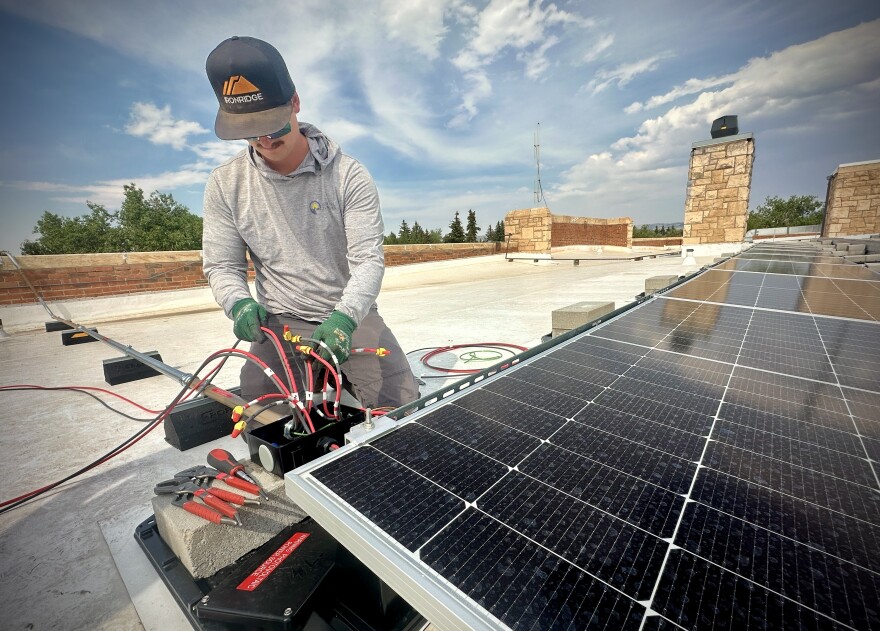Electrician Andrew Weatherford scrambled up the utility stairs of the Albany County Courthouse. He popped on the roof where several rows of black solar panels glistened.
“So they're angled a little bit so they can get the best production,” said Weatherford, looking at the system he installed over the last couple weeks. “It's facing due south.”
Weatherford is in his 30s and loves exploring Wyoming, so this job is a good fit. It takes him across the state, year-round.
“We're doing this when it's 100 degrees, plus, on some of these roofs in the summertime,” he said with a chuckle. “Then when we're working and it's December – clearing snow off roofs [when it’s] two degrees, zero degrees.”

On this late July day, Weatherford unspooled electric cords. They’ll run from the courthouse roof to a control box about 60 feet below.
“To connect the power that's produced from the solar panels to the building,” he explained.
This is a Creative Energies project, one of the few rooftop solar installers in Wyoming. The company is figuring out what their business model looks like under the Trump administration, as federal cuts are coming to the solar industry.
However, political headwinds are nothing new in this fossil fuel-driven state. The 24-year-old solar company has still managed to carve out a market for itself.
“We like to think of it as the epicenter of solar energy for the state of Wyoming,” said co-owner Scott Kane, giving a tour of the Creative Energy’s headquarters in Lander.
Sunflowers lined a giant shop building. Inside, they’ve outfitted a full-on hardware store: tools, electrical and solar equipment, trucks. Everything they need to service projects around Wyoming. Kane said they built it a couple years ago.
“We noticed, ‘Whoa, there’s been a lot of demand for solar and we're having a hard time keeping up with the demand that's out there,’” he said.
That was partly thanks to a federal tax credit for residential rooftop solar. The Biden administration beefed it up – the federal government covered about a third of the cost.

A version of the credit first came about under President George W. Bush. The Republican’s solar tax credit was supposed to taper down by 2008.
“It's been extended because subsequent administrations saw that the program was working well,” Kane said.
But just this summer Congress passed the ‘One Big Beautiful Bill.’ It completely phases out the 30% residential solar credit by the end of the year.
“So that went from being almost a 20-year long program to ending overnight,” Kane said. “That really feels like a scramble right now.”
A scramble to squeeze the surge of customers who want that cheaper price tag.
“We're almost at the point now where we need to start saying no to customers, that we can't get their project built before the end of the year,” Kane said.
Over half of Kane’s customers are residential. It’s unclear if they’ll still want his services next year when prices go up, and as a business that’s unnerving.

“Rather than continuing to add people and invest in vehicles and invest in new buildings, [we’re moving] to more of a, ‘Let's sustain the business’ mindset,” he said.
This concern exists across the nation. NPR reported that rooftop installers felt the demand surge in early January. Back then, homeowners anticipated the Trump administration would nix the federal tax credit. A more recent PBS report indicates the industry thinks rooftop solar demand could collapse.
Kane helped found Creative Energies in 2001 when Wyoming’s fossil fuels were booming.
“Some might say that, ‘A renewable energy company, you're operating in Wyoming? Like that must feel like you're operating behind enemy lines,’” Kane said.
But he’s actually found the opposite.
“Because people in Wyoming know energy, it's something of interest,” said Kane, adding that they’ve installed rooftop solar for natural gas companies.
The company certainly felt growing pains in the early years. Kane said they’d work job-to-job with a very small team. But they eventually found a niche market.
“The idea really plays that, ‘Hey, we grow our own food, we hunt for our own meat. Let's produce our own power too,’” he said.

So Kane’s hopeful that mindset will continue, even without the residential credit.
But, the commercial tax credits aren’t ending for another couple years. So Kane expects to tap more into those projects, like the Albany County Courthouse.
At the end of the hot July workday, electrician Andrew Weatherford fed the electrical cords to his work partner Noah Rohrbacher.
“We should be able to fire this system up and see what it's producing and see what it'll be able to do for the building,” Rohrbacher said, adding the courthouse to the more than 3,100 buildings with rooftop solar in Wyoming.







